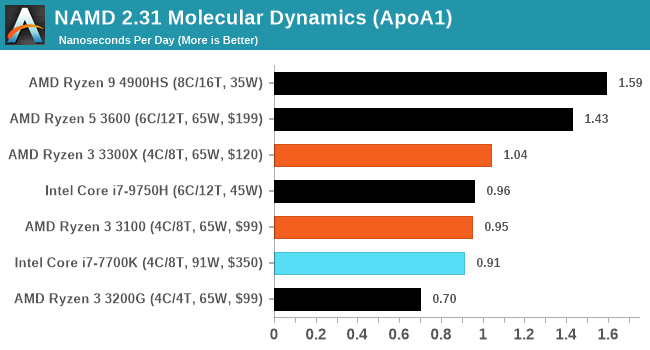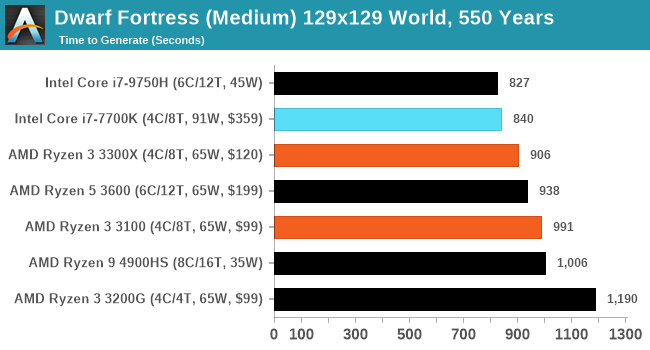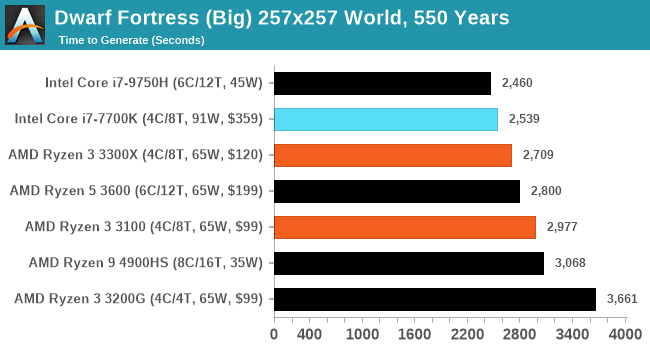The AMD Ryzen 3 3300X and 3100 CPU Review: A Budget Gaming Bonanza
by Dr. Ian Cutress on May 7, 2020 9:00 AM ESTCPU Performance: New Tests!
As part of our ever on-going march towards a better rounded view of the performance of these processors, we have a few new tests for you that we’ve been cooking in the lab. Some of these new benchmarks provide obvious talking points, others are just a bit of fun. Most of them are so new we’ve only run them on a few processors so far. It will be interesting to hear your feedback!
NAMD ApoA1
One frequent request over the years has been for some form of molecular dynamics simulation. Molecular dynamics forms the basis of a lot of computational biology and chemistry when modeling specific molecules, enabling researchers to find low energy configurations or potential active binding sites, especially when looking at larger proteins. We’re using the NAMD software here, or Nanoscale Molecular Dynamics, often cited for its parallel efficiency. Unfortunately the version we’re using is limited to 64 threads on Windows, but we can still use it to analyze our processors. We’re simulating the ApoA1 protein for 10 minutes, and reporting back the ‘nanoseconds per day’ that our processor can simulate. Molecular dynamics is so complex that yes, you can spend a day simply calculating a nanosecond of molecular movement.

Crysis CPU Render
One of the most oft used memes in computer gaming is ‘Can It Run Crysis?’. The original 2007 game, built in the Crytek engine by Crytek, was heralded as a computationally complex title for the hardware at the time and several years after, suggesting that a user needed graphics hardware from the future in order to run it. Fast forward over a decade, and the game runs fairly easily on modern GPUs, but we can also apply the same concept to pure CPU rendering – can the CPU render Crysis? Since 64 core processors entered the market, one can dream. We built a benchmark to see whether the hardware can.
Smooth#canitruncrysis pic.twitter.com/k7x31ULndF
— 𝐷𝑟. 𝐼𝑎𝑛 𝐶𝑢𝑡𝑟𝑒𝑠𝑠 (@IanCutress) May 4, 2020
For this test, we’re running Crysis’ own GPU benchmark, but in CPU render mode. This is a 2000 frame test, which we run over a series of resolutions from 800x600 up to 1920x1080.
| Crysis CPU Render Frames Per Second |
||||||
| AnandTech | 800 x600 |
1024 x768 |
1280 x800 |
1366 x768 |
1600 x900 |
1920 x1080 |
| AMD | ||||||
| Ryzen 9 4900HS | 11.50 | 8.75 | 7.44 | 6.83 | 5.21 | 4.30 |
| Ryzen 5 3600 | 9.98 | 7.84 | 6.69 | 6.15 | 4.75 | 3.92 |
| Ryzen 3 3300X | 8.42 | 6.52 | 5.43 | 5.01 | 3.92 | 3.07 |
| Ryzen 3 3100 | 7.50 | 5.78 | 4.87 | 4.5 | 3.54 | 2.77 |
| Intel | ||||||
| Core i7-7700K | 7.63 | 5.87 | 4.95 | 4.55 | 3.57 | 2.79 |
| Core i7-9750H | 6.78 | 5.17 | 4.37 | 3.99 | 3.12 | 2.46 |
Dwarf Fortress
Another long standing request for our benchmark suite has been Dwarf Fortress, a popular management/roguelike indie video game, first launched in 2006. Emulating the ASCII interfaces of old, this title is a rather complex beast, which can generate environments subject to millennia of rule, famous faces, peasants, and key historical figures and events. The further you get into the game, depending on the size of the world, the slower it becomes.
DFMark is a benchmark built by vorsgren on the Bay12Forums that gives two different modes built on DFHack: world generation and embark. These tests can be configured, but range anywhere from 3 minutes to several hours. I’ve barely scratched the surface here, but after analyzing the test, we ended up going for three different world generation sizes.



Interestingly Intel's hardware likes Dwarf Fortress.
We also have other benchmarks in the wings, such as AI Benchmark (ETH), LINPACK, and V-Ray, however they still require a bit of tweaking to get working it seems.










249 Comments
View All Comments
Spunjji - Monday, May 11, 2020 - link
What a worthless comment. Sure, they included high-end Intel CPUs in the gaming sections - but the review isn't *about* high-end CPUs, it's about what you get for the money with these specific AMD CPUs. Comparing AMD's budget gaming CPU to the best available to see how little you lose is a valid comparison to make.jjjag - Tuesday, May 12, 2020 - link
Anandtech can no longer write a simple factual article anymore about any processor. Even this article, which is supposed to be a simple article about a new low-cost processor, uses the word "Bonanza" in the title, mysteriously It also takes multiple jabs at Intel in the body, even though it servers no purpose to the actual content. Every Anand article is now an opinion piece instead of responsible reporting.Spunjji - Tuesday, May 12, 2020 - link
"I hate content with flavour. I want lists of graphs with no words."Good for you. Off you go to userbenchmark, for worthless, context-free information that's appropriately biased towards your preferred team.
rdgoodri - Friday, May 15, 2020 - link
Its pretty positive for AMD, don't catch your angle here.Meteor2 - Tuesday, August 4, 2020 - link
This article absolutely rips into Intel, and rightly so.Your comment is bizarre.
PeterCollier - Thursday, May 7, 2020 - link
And what's the point of these new benchmarks? I prefer PCMark and Userbench. Basically no one is using their new CPU to simulate the neurons of a sea slug, for example. Utterly irrelevant to real-life usage.Mansoor - Thursday, May 7, 2020 - link
The purpose of a benchmark is to produce repeatable and reliable numbers. Just "doing real-life stuff" is not repeatable and will generate different numbers for everyone. If you have a specific use case in mind, you can observe relevant or related benchmarks.PeterCollier - Friday, May 8, 2020 - link
None of my use cases mesh with any of the lousily selected benchmarks in this review.Korguz - Friday, May 8, 2020 - link
then why are you here reading this article ?PeterCollier - Saturday, May 9, 2020 - link
I read articles from all sources, including the silicon-equivalent of Faux News. I find it a good practice to read from sources that you disagree with, or worse, purposely mislead you, because it's important not to create an echo chamber for one's self.